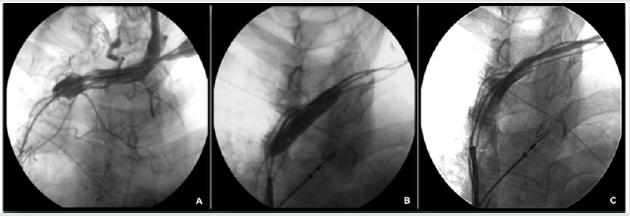Lupine Publishers | Journal of Cardiology & Clinical Research
Abstract
Keywords: Upgrading; Cardiac resynchronization therapy; Percutaneous transluminal angioplasty; Venous occlusion
Introduction
Case Report
Figure 1: Vein angioplasty procedure. A. Angiography from the subclavian venous access, revealing occlusive venous
stenosis of the anonimous trunk. B. Balloon inflated up to 8-10 atm. across the stenosis. C. Restoration of venous patency after
angioplasty.

A 0.014” angioplasty guidewire (TERUMO Corporation, Tokyo,
Japan) was threaded through the occlusion and then left in the right
atrium. An angioplasty balloon (Sterling 6mm x 20mm, Boston
Scientific Inc. Natick, USA) was then advanced over the wire to the
occlusion and inflated to 6 atm. In order to progressively open the
occlusion, we removed the balloon and advanced over the 0.014” wire
a multipurpose catheter (Cordis Corporation, Miami, USA) which,
thanks to the dotter effect, enabled us to pass through the stenotic
tract and to replace the 0.014” with a 0.35” x 200 cm guidewire.
Once we had retrieved the MP catheter, a larger angioplasty balloon
(Sterling 8 mm x 40 mm, Boston scientific Inc. Natick, USA) was
advanced over the 0.35” wire and repeatedly inflated to 10 atm to
obtain satisfactory dilation of the subclavian and innominate veins
(Figure 1B). A 5-10 cc injection of contrast medium confirmed the
re-establishment of flow within the subclavian vein and SVC, with
a residual stenosis of 30-40% (Figure 1C). Implantation of the CRT
device was then successfully carried out, without complications,
by cannulating the coronary sinus through a dedicated delivery
system (Attain Command Straight, Medtronic Inc. Minneapolis,
USA), placing a 4 Fr dual-unipolar LV lead (Attain Ability 4196-
88 cm, Medtronic Inc. Minneapolis, USA) into a lateral coronary
vein and, finally, by connecting the three leads to a CRT-D device
(Consulta CRT-D, Medtronic Inc. Minneapolis, USA). The acute
LV lead threshold was 1.1 V at 0.5 msec, with no diaphragmatic
capture at 10V. The electrical parameters of the right atrial and right
ventricular leads were also stable. The additional time required to
perform PTA was 15 minutes, plus 3 minutes of fluoroscopy time
with an additional 30 cc injection of contrast medium injection. At
the 3-month follow-up examination, electrical parameters of atrial,
right ventricle and left ventricle leads were stable, and no adverse
event was observed.
Discussion
As the stenotic process is usually gradual, a collateral venous network can develop to compensate for the occlusion. Consequently, symptoms or physical signs are rare, and partial or total venous occlusion may be totally asymptomatically, becoming an unexpected finding at the time of implantation. If a new lead needs to be added to the implanted system, the operative strategy may differ considerably according to the physician’s familiarity with the available technical options. The physician can choose among various approaches: an opposite-side approach with subsequent lead tunneling across the thorax [10], an ipsilateral approach performed by means of jugular system cannulation [11], and epicardial placement of the leads through thoracotomy or vein angioplasty [5]. The first option carries several risks, including the development of complete occlusion of both subclavian veins over time, damage to the leads — particularly deleterious in the case of ICD leads - or higher defibrillation threshold in the case of rightside placement of the active can. The jugular system approach may expose the patient to the risk of worsened blood drainage or, in the case of the internal jugular cannulation, even acute serious damage to this important vessel of the neck [12]. Epicardial placement of the leads through thoracotomy has the disadvantage of requiring surgery and general anesthesia.
Our experience showed that angioplasty of the central venous system can be performed in the same session of the upgrading procedure without excessively prolonging the procedural time, thereby avoiding postponing the procedure. We observed no complications, damage or dislocations of the existing leads. Moreover, this approach is less invasive than other alternatives and allows the patency of the contralateral venous system to be preserved. This case also shows that in certain clinical conditions at higher risk of venous occlusion, it is advisable to perform an angiography from ante cubital vein before the procedure, in order to assess the patency and exact location of the great veins. We can hypothesize that incomplete location of the second shocking coil inside the superior vena cava and the lying of the coil across the junction between the innominate vein and superior vena cava may contribute, for hemodynamic reasons, to the development of a marked fibrotic reaction. Eventually, in case of occlusive stenosis of central veins, intraprocedural venoplasty of great vessel seem to be feasible, without postponing the upgrading procedure.
https://lupinepublishers.com/cardiology-journal/pdf/ACR.MS.ID.000128.pdf
https://lupinepublishers.com/cardiology-journal/abstracts/troubleshooting-in-upgrading-procedure-intraprocedural-percutaneous-transluminal-angioplasty-of-great-vessels.ID.000128.php
For more Lupine Publishers Open Access Journals Please visit our website
For more Journal of
Cardiology & Clinical Research Please Click Here:
To Know more Open
Access Publishers Click
on Lupine
Publisher
Follow on Linkedin : https://www.linkedin.com/company/lupinepublishers
Follow on Twitter : https://twitter.com/lupine_online
No comments:
Post a Comment